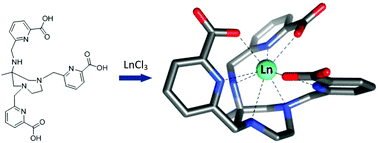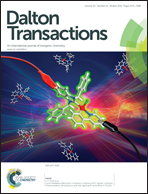AMPED: a new platform for picolinate based luminescent lanthanide chelates†
Abstract
The synthesis of a new nonacoordinating ligand based on an AMPED (6-amino-6-methylperhydro-1,4-diazepine) scaffold functionalized by three picolinate (6-carboxy-2-methylpyridine) arms is described. Coordination of lanthanide cations (Ln = Eu and Tb) was investigated by spectrophotometric titrations monitored by UV-Vis absorption and steady-state emission spectroscopy, showing the formation of [LnL] complexes in aqueous solutions. The corresponding Eu and Tb complexes were isolated and characterized, and their spectroscopic properties (luminescence quantum yields, excited state lifetimes) were determined in buffered water (TRIS/HCl, pH 7.4) and compared to the data reported in the literature for related systems. DFT modelling of the complexes showed the picolinate arms to be perfectly wrapped around the Ln3+ cations, affording an excellent shielding of the metal as confirmed by the determination of the hydration number of q = 0 for both complexes. The high resolution emission spectrum was used to determine the radiative lifetime of Eu in the complex (τrad = 3.05 ms) and the metal-centred luminescence quantum yield (0.20). The modest 0.10 overall luminescence quantum yield of the Eu complex is a consequence of an energy transfer with medium efficiency (0.50) and a low metal centred luminescence efficiency attributed in part to the presence of numerous NH and CH bonds in close proximity to the metal centre.


 Please wait while we load your content...
Please wait while we load your content...